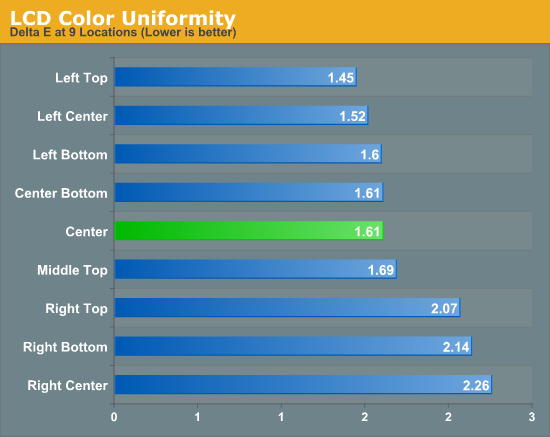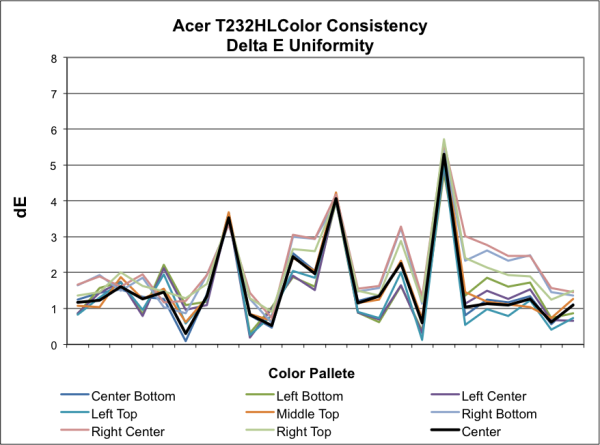Acer T232HL - Touch Comes to the Desktop
by Chris Heinonen on February 6, 2013 9:00 AM ESTDisplay Uniformity
For some reason, display uniformity is where I see a big issue with the Acer T232HL. Using a 5x5 ANSI grid, there is a clear drop in light output on the right side of the screen. While the center is at 200 nits, this whole column of values is below 180 nits, for at least a 10% reduction in light output.
| Top | ||||||
| Left | 218.2 | 215.4 | 197.2 | 172.3 | 188.1 | Right |
| 206.1 | 206.4 | 192.9 | 179.9 | 188.9 | ||
| 213.2 | 207.3 | 199.7 | 179.0 | 179.5 | ||
| 207.5 | 206.1 | 193.4 | 180.8 | 187.9 | ||
| 217.9 | 209.8 | 187.5 | 167.9 | 193.5 | ||
| Bottom | ||||||
Additionally the left side of the screen is really bright, leading to variations across the screen of up to 50.3 nits. This is a huge difference and one that is easily noticeable by average users. I really haven’t seen anything come close to this before, as usually the smaller differences in screen brightness are something I can accept. Looking strictly at the average values the screen looks good, but with the raw values and the surface chart you can see that something is clearly wrong here.
Looking at the black uniformity this issue is still there. It’s not as easy to see because of the lower numbers, but you can see it drop in the same area as before. The incredibly bright spot at the bottom is a bit strange, but I did the reading multiple times to verify that it was correct. All of the corners except for the upper-right have a good bit of light bleed in them as well.
Because both black and white levels have issues in the same part of the screen, contrast uniformity is actually pretty good on the Acer! That’s a bit of damning with faint praise, but since the contrast ratios are very good, it is a bit of a bright side. There is a big drop in the center-bottom reading, but overall the contrast stays pretty close to the 1000:1 level that we measured earlier.
As expected, the weird uniformity issues are here to mess with the color uniformity as well. The average dE for the screen is 1.77 relative to the 1.61 for the center, but the average for the right side is 2.16, a good amount above the center figure. The largest issue seems to be in the grayscale, as the right side produces the three worst results for the grayscale on the whole. All of the values stay at or below 3.0, but it is still much worse on that side than on the center or left side of the display.

Unfortunately, the Acer has a serious issue with panel uniformity, one that could be the result of a number of things. In the end, it is a serious flaw on the display and one that I haven’t seen be so bad in the past.















66 Comments
View All Comments
pandemonium - Wednesday, February 6, 2013 - link
The only way I can use a touchscreen for a desktop computer will be with a drawing table layout with the screen actually in the desk. *patent!!*Operandi - Thursday, February 7, 2013 - link
Bring on 4K IPS/VA panels and stop making worthless crap.Dribble - Thursday, February 7, 2013 - link
It just doesn't work. You want your arms relaxed in front of you - hence the design for mice + keyboards.Where touch screens work you tend to be looking down at them and have them close to your body so you arms stay relaxed. This is not the case for a desktop monitor - you cannot keep your arms vertically out in front of you for any length of time - it's very tiring.
Hence the whole concept is flawed which anyone with half a brain could have told MS/Acer.
Beaver M. - Thursday, February 7, 2013 - link
Exactly. Though I can imagine, that a hype would press it anyway. Doesnt matter that spine and arm problems will skyrocket after that.TheGreenFoX - Thursday, February 7, 2013 - link
If you have a primary gaming screen with a fullscreen game on, and a touch screen with the metro interface as 2. screen - will the game minimize if you make a touch input on the touchscreen, or can you use the metro apps without minimizing the game?chaoticlusts - Thursday, February 7, 2013 - link
Will be interesting too see how the interface devices due out this year compare with touch screen desktop monitors for convenience.I don't really see touch on a desktop screen being very convenient for most people unless you rearrange your setup around it... and even then it would hard not to be awkward. Touch works great on laptops and smaller devices but I really think if people want the 'hands on' approach with desktops things like Leap Motion or the Kinect 2 will take off rather than products like this. even more so when it means adding a $100 device rather than paying hundreds extra for a touch monitor.
beck2050 - Thursday, February 7, 2013 - link
Touch my screen on a desktop is uncomfortable and unacceptable for me.I would never want a touchscreen there.
ypsylon - Friday, February 8, 2013 - link
It is really one environment where touch screen is nothing more than a nuisance. Imagine situation like this.You have a desk, on a desk is LCD 27"-30". LCD is standing as it should ~50-60 cm from user so his/her eyes won't bleed after 10 seconds. How the hell somebody thinks (Microsoft for that matter) that user will sit even closer, virtually next to a big LCD pushing buttons on the screen. Really laughable idea. Imagine writing something in the office or doing really complicated spreadsheet just with virtual keyboard stretching you arms across the desk. And if user must keep his/her beloved keyboard and mouse because nobody else on the market cares about touch screen software then idea of a touch screen for desktop is as dead as ISA slot on motherboards.
There are environment where touch screen is used for ages: manufacturing, finances (stock exchange), military, engineering and so on. For now home-desktop area is a no-go zone. We haven't exactly reached Star Trek level of computerization where with few taps on a pad you can run a starship. :D
JimmiG - Friday, February 8, 2013 - link
The whole reason Apple went with touch on the first iPhone was to get the most effective use of the limited screen real estate and surface area of a phone.It is *not* the best interface for large screens or desktop computers where a mouse and keyboard is available. This silliness needs to go away.
DagB - Friday, February 8, 2013 - link
Comments like this really bugs me, especially on a site like this... Where is the forward thinking? Do you actually think people will sit with a mouse and keyboard in 20 years to the same extent they do today? There are lots of interesting things happening; touch, motion sensors, haptic technologies and so on. I agree that this is probably not an optimal interface if you mainly type or do normal "office" work. But there are people doing other stuff as well on there desktops. For example all types of "creative" activities (film editing, photo editing, music producing etc).For me as a music producer this is something really interesting, that has the potential to totally change the way we produce, mix, create and edit music. Ipad is way to small/limited for more advanced work, but is still very interesting. If you put a large desktop screen (more) horizontally, you will not get tired after hours of work and would have all the real estate you need. Also, that is the work position producers and sound engineers have worked for decades. I hope this is just the beginning of a change to a more intuitive and "direct" way of interacting with our digital tools. We should embrace it!